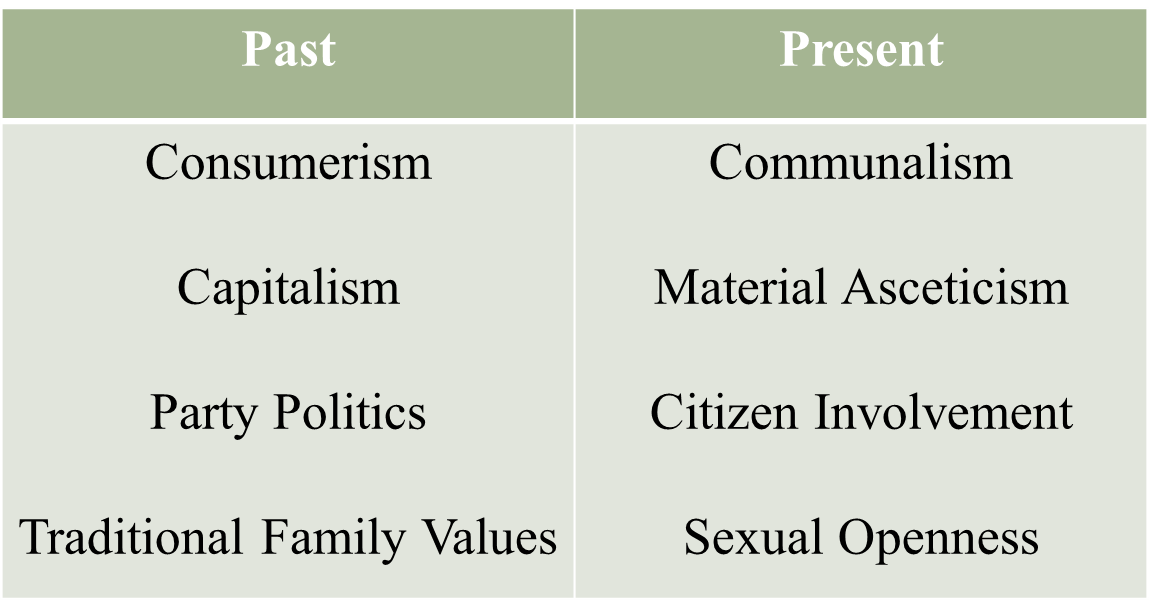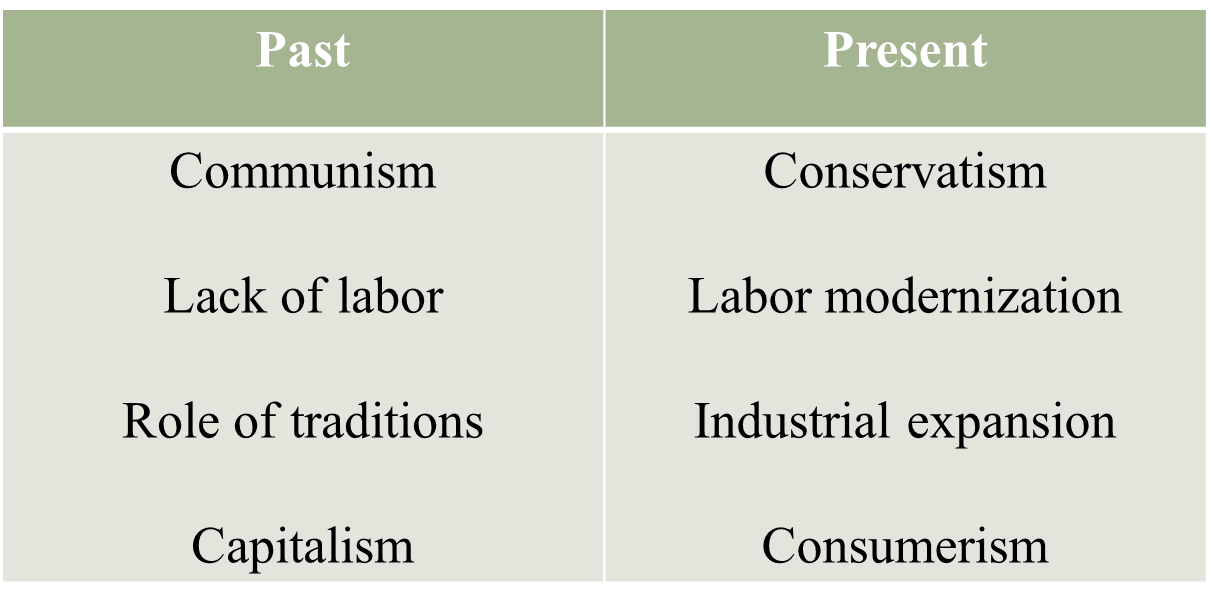Introduction
World War Second was a significant event in Europe, the United States, and the whole world. It was characterized by a number of political, economic, and social changes. However, being ended in 1945, its outcomes challenged many countries during the next several decades. The division of Europe into Western and Eastern was the major WWII aftermath, and this work aims at comparing the situation in the regions between 1963 and 1989. Such aspects as political extremism (government changes), economic instability (hard to control ups and downs), social improvements (family values, student revolts, and feminism), and the relationships between Europe and America (unwillingness to continue cooperation) are taken into consideration.
Political Situation in Western Europe
The period between the 1960s and the 1980s was difficult for Western Europe from a political point of view. First, the decision to support European integration was made, and government policies were changed accordingly. Some countries were not prepared for them, and some nations strived to demonstrate their potential. Instead of following the same ways of development, western countries preferred different forms of governance:
- France chose a presidential republic under the rule of de Gaulle;
- Britain was the country were conservatives benefited with Margaret Thatcher as a leader (her passion and desire to prove can be observed on the image), and the Labor Party resisted their regulations;
- Italy introduced Christian democracy who emphasized individualism;
- Western German was focused on anti-communism ideas;
- Authoritarianism of Spain made the region rich and capable of development.
- New radical directions and terrors challenged politics from time to time.
Political Situation in Eastern Europe
The Soviet Union was the leading nation in Eastern Europe after WWII, and the choice of leaders defined its further political, economic, and social changes. In the time period under analysis, the two forms of governance were applied: communism was introduced by Khrushchev (right image) who replaced Stalin, and conservatism by Brezhnev (left image) who replaced Khrushchev. Communism was characterized by fast growth in terms of the Council of Mutual Economic Assistance (COMECON), a strong post-war initiative to strengthen economic relations in Western Europe. It was also important to elucidate new policies according to which social interests and values were changed and politically approved. Conservatism, in its turn, did not focus on changed but on the improvement of national defense and political stability. It was expected to underline the role of authority in the Soviet Union, as well as other countries of Eastern Europe.
Economic Situation in Western Europe
In Western Europe, the change of power and unstable international relationships resulted in dramatic changes for the population, including:
- Depression because of unstable inflation rates and the growth of unemployment.
- Financial and oil crises were caused by the sudden rise in prices on fuel and the inability to increase limited supplies (image as evidence).
- Poverty was extreme in such regions like South Italy, the Balkans, and Spain, and the role of the bourgeoisie was re-evaluated in France.
- The US-European economic conflict included trade rivalries, the presence of multinational (American) firms in Europe, and the stability of the US dollar as the only international currency.
- Immigration was not popular at the beginning of the 20th century, but after WWII, people wanted to visit Europe and found new sources of incomes and growth.
Economic Situation in Eastern Europe
The economic situation in Eastern Europe was not stable, but almost every change could be explained and understood. During the leadership of Khrushchev, communism was a defining power that did not allow illegal or any immigration happen. This form of governance promoted consumerism as a motivational factor in the countries’ development. It was necessary for the government to gain all forms of economic control, including private business, centralized banking, and foreign trade. In addition, industrialization and the importance of new housing reforms contributed to the growth rate. However, new course reforms decreased capital investments, focusing on the expansion of steel and coal only. With time, the oil crisis and environmental concerns caused a new wave of discontent. Both Khrushchev and Brezhnev supported the idea of extended education to promote modernization and find people for white-collar jobs.
Social Situation in Western Europe
The social situation in Western Europe was not unstable because of the emergence of various movements. The ideas of nationalism and civil rights were observed in almost all countries, proving people’s intentions to get rid of American influence and dependence. Environmentalism introduced a new way to develop political and economic relationships and appreciate the role of nature in human development. Feminism was another strong aspect of social growth when women gained a new status of independence and power in society. On the image, student revolts are depicted as a part of social change in such countries and France, Britain, and Italy. Students wanted to reduce the impact of the United States on nuclear power in Europe and promote peace and anarchy in their communities.
Social Situation in Eastern Europe
Compared to Western Europe where equality and democracy were promoted, the social situation in Eastern Europe was controlled by the government. Both positive and negative changes went hand in hand during the next five decades after WWII. In their intentions to promote urban lifestyles in society, the government neglected or diminished the role of traditions and families. Communism was a powerful tool that kept order even in the most uncontrolled societies.
The image on the slide shows how communism was introduced and accepted in Czechoslovakia. Expanded literacy was promoted at the expense of families and the necessity to keep them small. Gang violence occurred in different countries, but it was decided to control youth by means of new activities, parties, and responsibilities. The transition between communism and conservatism offered new opportunities like living standards, the absence of inequality, and housing. However, health problems were poorly controlled, which shortened life expectancy considerably.
Changes in Western Europe

In Western Europe, certain changes occurred in regards to the attitudes towards people and their roles in society. For example, consumerism (when attention was paid to people as potential consumers) was replaced with communalism (when people were differentiated by their belonging to certain communities). Asceticism deepened the ideas of capitalism and underlined the worth of material goods for further development and professional growth in different fields. Instead of parties and their politics, attention was paid to citizens and their contributions. Finally, the government began replacing traditional family values and beliefs with openness in relationships, including human and sexual. People were ready to make their lives public and discuss their achievements openly without the feelings of shame but pride and power.
Changes in Eastern Europe

In Eastern Europe, political, social, and economic conditions depended directly on the leaders of the Soviet Union and their readiness to cooperate with other nations. For example, communism was the ideology with strict rules and obligations for people to protect their property rights. Instead of equality, people had to choose in regards to their opportunities. However, structural economic problems gave raise to conservatism and consumerism. The lack of working places was not a problem anymore because conservatism opened new opportunities and promoted modernization of labor. Instead of the role of traditions and material satisfaction, people were involved in the promotion of industrial expansion. Citizens became the major consumers, and their needs removed capitalism and inequality, approaching to individual needs.
Conclusion
In general, the situation in Western and Eastern Europe differed considerably from political, economic, and social aspects. Due to the presence of various forms of governance, Western countries had to deal with radical movements and poorly controlled the populations. Economic conflicts with the US raised because of the intentions to gain more benefits and reduce the level of dependence. Such social aspects as gender roles and immigration differentiate the west from the east where women’s domination was not allowed, and people did not want to migrate there because of communism that was replaced by conservatism with time. The ideas of consumerism and living standards motivated people, but the governmental control was harsh not to allow such processes as industrialization, urbanization, and modernization change the views of citizens.
References
de Beauvoir, Simone. “The Second Sex.” In Sources of European History: Since 1900, edited by Marvin Perry, Matthew Berg, and James Krukones, 633-636. Boston, MA: Cengage, 2000.
Halevi, Joseph, and Peter Kriesler. “Stagnation and Economic Conflict in Europe.” International Journal of Political Economy 34, no. 2 (2004): 19-45.
Kovály, Heda Margolius. “Under a Cruel Star.” In Sources of European History: Since 1900, edited by Marvin Perry, Matthew Berg, and James Krukones, 624-629. Boston, MA: Cengage, 2000.
Paxton, Robert O. and Julie Hessler. Europe in the Twentieth Century. 5th ed. Boston, MA: Cengage Learning, 2012.
Raundalen, Jon. “A Communist Takeover in the Dream Factory – Appropriation of Popular Genres by the East German Film Industry.” Slavonica 11, no. 1 (2005): 69-86.